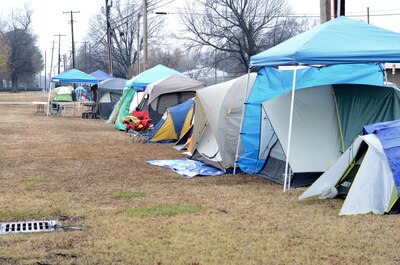When applications for optional schools go online at 10 o’clock on Monday morning, it will mark the end of “tent city,” where Memphis parents camp out for days to be the first in line to submit paper applications for the city’s most popular schools.
Critics of the previous application process laud the shift online as a significant step toward letting more families get a shot at the most selective schools in Shelby County Schools. After all, most low-income families didn’t have the ability to stop work and camp out in the middle of winter to secure spots for their children.
But the new process still doesn’t level the playing field completely.
The time-sensitive nature of the online application still favors families who have more flexible schedules.
And the Digital Divide makes it challenging for low-income families who don’t have computer or Internet access.
“What they’re doing now is a step ahead of staying out in those tents, but there are still things that we could be doing better,” said Billy Earle, whose grandson attends Snowden School, an optional school that was his family’s second choice after applying last year on the first day.
Optional schools were created under the former Memphis City Schools beginning in the 1970s to attract and retain high-achieving students and stem white flight following efforts to desegregate Memphis schools. But in trying to address that concern, the district contributed to an inequitable distribution of resources and opportunities in a district where 60 percent of the students come from low-income families.
The previous application process was especially frustrating, since many low-income parents work more than one job and didn’t have the flexibility to secure a first-come, first-serve spot.
Under the new online system, Shelby County Schools is trying to mitigate any inequities by making the application mobile-friendly and by opening computer stations for parents at all schools, as well as the district’s welcome center, headquarters and several satellite offices. It’s also encouraging parents to take advantage of internet access at public libraries and shared a sample application in advance so parents can know what information they’ll need.
Most families who apply for one of the 46 optional schools get their first choice if their student meets academic requirements. That’s because there’s enough room for them. But it’s harder to secure a spot in the most popular optional schools such as Maxine Smith STEAM Academy and Peabody Elementary.
For schools that fill up, 80 percent of the applications will be processed on a first-come, first-served basis. The remaining 20 percent will be chosen by lottery at a later time.
District officials say the school system’s online platform is equipped to handle the high volume of traffic anticipated Monday morning when the application window opens. It’s the same platform used to handle school transfer requests.

“Each year, we receive several thousand (transfer requests) on the first day of the application period and have not experienced any difficulties,” says a district statement. “We are anticipating far more applications this year since the Optional application is online too; however, we do not expect any challenges with access or functionality.”
Jim Lord is among parents who have endured the January campout on the lawn of the central office to get his child in an optional school. He’s glad parents won’t have to do that this year, but notes that the new process doesn’t solve the bigger problem. Access to high-quality schools shouldn’t be limited, he says, to resources or location.
“The ideal solution is to have more schools that end up filling their spaces, and in all areas of the county,” he said, “so that all kids who qualify have the opportunity to attend a great school that challenges them.”

